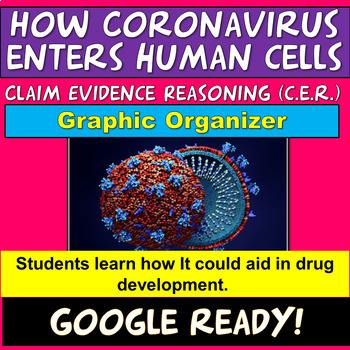Coronavirus Claim Evidence Reasoning Digital COVID Invades Cells
- Zip
- Google Apps™

Description
Students learn how scientists figured out how the new Coronavirus breaks into human cells and how that may lead to a vaccine through a C.E.R. (Claim Evidence Reasoning) graphic organizer. This is great for getting your students to explain phenomena in a meaningful way and it allows you as the instructor to adequately assess their understanding of concepts. The students figure out what the "Claim" is in the article, they then use data that supports the claim in the "Evidence" section, draw visual evidence and then explain why the evidence supports the claim in the "Reasoning" section.
The article has the following concepts:
Coronavirus
Cells
Atoms
Virus
Receptor
Human host
Molecule
Molecular bond
Viral spike protein
Electron microscopy
Amino acids
Outbreak
Immune system
Vaccine
Severe Acute Respiratory Syndrome (SARS)
Take a look at my CER Mega bundle!
Take a look at more Coronavirus CER’s:
-Molecular Structure of Coronavirus Found
This is great for a current event, sub plan, homework, critical thinking, scaffolding and/or reinforcement of concepts!
You get a CER graphic organizer, an editable key, the article, tips for CER, a link to make it Google Ready, and the link to the website in the article.
NGSS Standards:
SEP's Asking Questions and Defining Problem:
Students at any grade level should be able to ask questions of each other about the texts they read, the features of the phenomena they observe, and the conclusions they draw from their models or scientific investigations.
Engaging in Argument from Evidence:
In 9–12 builds on K–8 experiences and progresses to using appropriate and sufficient evidence and scientific reasoning to defend and critique claims and explanations about the natural and designed world(s). Arguments may also come from current scientific or historical episodes in science.
CCC's: Patterns
Observed patterns of forms and events guide organization and classification, and they prompt questions about relationships and the factors that influence them.
Thank you for taking a look!
Please follow me on TpT for new products and check me out on Instagram for my products in action!
https://www.instagram.com/williamshandsonscience/
Related Products
⭐ Claim Evidence Reasoning (CER): Autumn Equinox Can Fall on Different Days
⭐ Claim Evidence Reasoning Growing Bundle
⭐ NGSS Black Holes & Galaxies Claim Evidence Reasoning Graphic Organizer
⭐ NGSS Claim Evidence Reasoning (CER) Big Bang Graphic Organizer
⭐ NGSS Claim Evidence Reasoning (CER) High Frequency Sound Waves
⭐ NGSS Claim Evidence Reasoning The Mysterious Planet Nine Solar System Astronomy
⭐ NGSS Claim Evidence Reasoning (CER) Water Found on Mars
⭐ ⭐ NGSS Common Core Claim Evidence Reasoning (CER) Graphic Organizers
⭐ NGSS Expanding Universe Claim Evidence Reasoning Graphic Organizer





